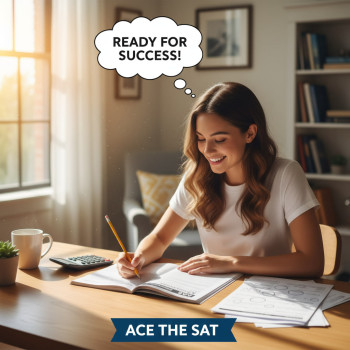Start With Breath, Not Blame: Why the Post-SAT Talk Matters
The minutes, hours, and days after your teen finishes the Digital SAT are a unique container of feelings: relief, exhaustion, curiosity, disappointment, pride. That emotional swirl is where meaningful learning happens — if you handle it with curiosity and calm rather than pressure or judgement. The conversation you have after the test sets the tone for everything that follows: whether your teen will learn from this experience, recharge and move on, or spiral into doubt.
Think of this debrief as a team huddle after a game. You’re not re-litigating every play; you’re noticing what worked, what to adjust, and what to celebrate. Done well, it builds confidence, clarifies next steps, and strengthens your relationship.

Before the Conversation: A Quick Prep Checklist for Parents
Preparation doesn’t mean rehearsing a script. It means clearing your head, gathering useful information, and choosing a time when both of you are emotionally available. Here’s a short checklist to help you set the scene.
- Wait for a calm moment — ideally later the same day or within 48 hours.
- Have basic facts ready: when scores will be released, where they’ll appear, and how score-sending works.
- Decide your tone: curious and supportive beats corrective and critical every time.
- Prepare a small list of open-ended questions (examples below) so the talk stays teen-centered.
- Resist the urge to compare scores to other students or to college cutoffs — that can quickly shut down honest conversation.
Open-ended prompts to start the conversation
- “How do you feel about how today went?”
- “What felt easier than you expected? What felt harder?”
- “If we were giving a grade to your test-day routine, what would you change next time?”
Emotion First, Then Data: Navigating Feelings and Facts
When students are tired or anxious, facts about score scales and percentiles mean little. Begin the debrief by validating feelings: exhaustion, relief, anger, whatever comes up. Only after emotions are heard does the data become useful.
Once your teen feels listened to, gently move toward the facts. For the Digital SAT, remind them that scores are reported digitally and that detailed score reports and insights will follow. If you don’t yet have scores, acknowledge that waiting is hard and set a plan for reviewing results together when they arrive.
Interpreting the Score: A Simple, Teen-Friendly Framework
When scores arrive, they contain a lot of information: total score ranges, section scores, and sometimes evidence-based sub-scores and question-level insights. Break the interpretation into three digestible steps so it doesn’t feel like swimming in unfamiliar jargon.
- Big-picture: What is the overall score and how does your teen feel about it?
- Pattern-spotting: Which sections or question types were stronger or weaker?
- Decision-time: Based on goals and deadlines, what is the next actionable step?
How to translate scores into action
Use a calm, nonjudgmental tone. If the score is near the target, the plan might be small tweaks and maintenance practice. If the score is below the target, the plan could include targeted practice, a retake, or an alternative strategy emphasizing other parts of the college application (coursework, essays, activities).
| Score Situation | Short-Term Response | Possible Longer-Term Plan |
|---|---|---|
| At or above target | Celebrate, maintain skills, confirm score sends | Small practice sessions; focus on college essays and application polishing |
| Within reach of target | Create a 4–8 week review plan; focus on weak question types | Targeted tutoring, timed practice, and a second test date if schedules allow |
| Significantly below target | Stabilize emotions, assess resources and deadlines | Structured tutoring, retake strategy, or portfolio/essay emphasis |
Ask Smart Questions — Shift From Critique to Curiosity
The quality of your questions determines the quality of the answers. Replace statements like “You should have studied harder” with curiosity-driven questions that invite honest reflection. These help your teen take ownership of next steps.
- “What parts of the test felt fair and what parts felt confusing?”
- “Were there specific question types that kept coming up that we should focus on?”
- “How did your test-day routine go — sleep, food, timing?”
- “If you could redesign your prep, what would you keep and what would you change?”
Turn Insight Into a Plan: Creating a Practical Follow-Up Strategy
Good intentions are nice; concrete plans actually move the needle. Here’s a simple, flexible structure to co-create a follow-up plan that fits your teen’s life.
- Set a single, clear target. (E.g., “Add 30 points on Reading and 40 on Math by March.”)
- Choose three focus areas (skills, content, test-strategy).
- Commit to time: short, daily micro-practice beats rare marathon sessions.
- Pick a progress check cadence: weekly quick check-ins and one full practice test every 3–4 weeks.
- Decide logistics: will your teen study alone, use Khan Academy practice, join group review, or schedule 1-on-1 tutoring?
For many families, a mix of resources works best. Personalized tutoring — for example, 1-on-1 guidance with tailored study plans and expert tutors — can accelerate progress because it targets the student’s specific question-level weaknesses rather than offering generic practice.
Concrete Study Plan Template (8 Weeks)
This template is an adaptable road map you can tailor to your teen’s schedule and goals.
- Weeks 1–2: Diagnostic review and fundamentals (focus on weakest area)
- Weeks 3–4: Strategy and timed practice (learn pacing, elimination, and shortcut strategies)
- Weeks 5–6: Mixed practice and error logs (review mistakes and set up patterns)
- Weeks 7–8: Full-length practice tests and fine-tuning (simulate test-day conditions)
Use Data, But Don’t Be a Slave to It
Digital score reports can show question-level performance and topic-level patterns. Those specifics are incredibly useful, but avoid over-focusing on single-number anxiety. Use the data to guide study choices, not to define your teen’s worth.
Example: if the report shows a consistent struggle with multi-step algebra questions, that’s a perfect target. It’s fixable, and improvement is measurable.
Practical Tools and Resources to Recommend (Without Overwhelm)
There are many resources — free and paid. The trick is to choose a small set and stick to them. Too many tools lead to scattered practice.
- Official practice materials and digital practice sets.
- Adaptive practice platforms or personalized online tutoring for targeted weaknesses.
- Timed, full-length practice tests to build stamina and pacing comfort.
- Error log or a simple spreadsheet where the student records question type, mistake, and fix.
When a family wants a higher-touch option, Sparkl’s personalized tutoring can be a beneficial fit: one-on-one guidance, tailored study plans, expert tutors who translate report insights into focused practice, and AI-driven insights that track progress. That said, whether to use a tutor depends on schedules, budgets, and how motivated your teen feels about retesting.
When to Retake the SAT — Practical Timing and Emotional Considerations
Deciding to retake should balance schedule, college deadlines, and realistic improvement windows. Retaking makes sense when there’s a clear plan to address weaknesses and enough time before application deadlines to implement it.
If deadlines are tight, you might prioritize strengthening other parts of the application — supplemental essays, grade trends, or extracurricular highlights. If a retake is feasible, aim for a retake after 6–12 weeks of focused practice depending on the amount of work required.
Keep Perspective: The SAT Is One Part of a Bigger Story
Colleges look at the full application. A single test score rarely defines a student’s potential. Encourage your teen to see this score as one chapter in their academic story — a data point that will inform future steps, not a verdict on talent or future success.
Handling Disappointment: Language That Heals
If the score disappoints, words matter. Try these phrases to comfort and motivate without minimizing the feeling:
- “I’m proud of your effort today — you handled it with grit.”
- “This result is a problem we can work on; it doesn’t define you.”
- “Let’s look at what the score tells us and build from there.”
Avoid phrases that compare, pressure, or try to immediately fix the emotion. Let the disappointment land for a bit; then pivot to a practical plan when your teen is ready.
Celebrate Wins — Even Small Ones
Improvement is rarely a single giant leap. Celebrate smaller wins: a whole week without missing a practice session, mastering a tricky concept, or a practice test showing steady progress. Positive reinforcement sustains motivation.
Practical Conversation Scripts (Short, Realistic, Human)
Here are short scripts you can adapt — choose one that feels like you.
- Curious and calm: “Tell me one thing that surprised you today and one thing you felt good about.”
- Plan-focused: “If you wanted to improve one thing before a retake, what would it be? Let’s make a tiny plan together.”
- Supportive and practical: “You’ve been working hard. If you want help creating a study plan, I’ll help schedule it — or we can explore a tutor together.”
Role of Parents: Coach, Advocate, and Buffer
Parents who do best in the SAT process tend to be supportive coaches. That means providing structure and resources (like arranging tutoring or blocking study time), advocating with schools if needed, and buffering stress — not micromanaging practice minutiae.
Keep the lines of communication open: ask how they want to be supported, and check in weekly rather than daily so your teen maintains autonomy.
When to Bring in Extra Help (Tutors, Counselors, Tools)
If your teen isn’t improving despite honest effort, or if they get stuck on very specific patterns (timing, multi-step problems, or test anxiety), individualized help can make a big difference. Look for tutors who:
- Start with diagnostics and an evidence-based plan.
- Offer one-on-one time focused on the student’s question-level patterns.
- Track progress with measurable benchmarks and adapt accordingly.
Sparkl’s tutoring model — pairing students with expert tutors who create tailored study plans and use AI-driven insights to track progress — is one example of a targeted, high-touch option that fits many families’ needs. But always confirm the tutor’s approach feels collaborative with your teen before committing.
Practical FAQ — Quick Answers to Common Parent Questions
- Q: “When will scores be available?” A: Scores for weekend administrations are usually released within a few weeks — check official release windows and your College Board account for specifics.
- Q: “Should we cancel plans if scores are disappointing?” A: No. Routine, rest, and normalcy help your teen process and recover faster.
- Q: “How many times should my teen take the SAT?” A: Most students take it 1–3 times. Each retake should have a focused, measurable plan behind it.
Long-Term Outlook: College Applications and the Bigger Picture
Remember: test scores are one slice of an application pie that also includes grades, essays, recommendations, and activities. A thoughtful, mature debrief after the SAT can actually become content for an application narrative — a story about resilience, thoughtful growth, and intentionality. Colleges respond well to students who can reflect on setbacks and clearly articulate what they learned.
Final Checklist: A One-Page Guide to Debriefing the Digital SAT
- Wait for a calm window (same day or within 48 hours).
- Lead with feelings; validate before analyzing.
- When ready, review scores together using the three-step framework: big-picture, pattern-spotting, decision-time.
- Create a focused action plan: target areas, time commitment, resources, and a retake decision if needed.
- Celebrate small wins and keep perspective on the whole application.
- Consider one-on-one tutoring if progress stalls — look for tailored plans and measurable benchmarks.

Parting Thought: The Conversation Matters More Than the Score
In the weeks and months that follow the Digital SAT, what your teen remembers most won’t be the exact number on the screen — it will be how you responded. A calm, curious debrief builds agency, teaches reflection, and models how to face challenges with intention. Whether you’re celebrating or strategizing, remember that your role is to be a steady ally: someone who listens, helps translate data into doable steps, and keeps the long-term view in sight.
If you and your teen decide you want structured, personalized support, know there are options that combine human coaching and smart, data-driven insights. The right support can make practice feel less like guesswork and more like progress. And ultimately, the best outcome is a student who learns from the experience, grows in confidence, and moves toward college with clarity — not exhaustion.
Take a breath, share a quiet moment, and then shape one simple next step together. That small, steady action is the true lever of progress.












No Comments
Leave a comment Cancel